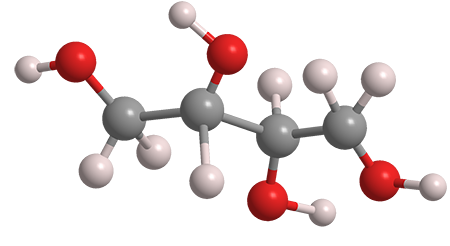What molecule am I?


Erythritol (aka meso-erythritol to distinguish it from other isomers) is a natural sweetener that is also manufactured by fermenting glucose. Even though it contains two chiral centers, it has no optical rotation because the molecule as a whole is symmetrical.
In 1900, Max Bamberger and Anton Landsiedl at the Vienna University of Technology isolated erythritol from the alga1 species Trentepohlia jolithus. Other researchers soon found it in organisms as disperse as lichens and grasses. But much earlier than these findings, eminent chemist August Wilhelm von Hofmann at the University of Berlin reported its synthesis in an 1874 article titled “Synthesis of the ethereal oil of Cochlearia officinalis” (a flowering plant in the family Brassicaceae).
Erythritol is about two-thirds as sweet as sucrose, but it is not caloric and does not contribute to tooth decay or blood sugar. Since the 1990s, it has been marketed as a low-calorie sweetener, often in combination with monkfruit (Siraita grosvenorii) extracts (mainly the glycoside mogroside V2) and D-tagatose3, a sugar derivative obtained from galactose4.
Despite its widespread use, erythritol has its downsides. In 2022, the northern California Meritage Medical Network published an article citing its side effects and dangers. It stated:
Erythritol side effects typically include digestive problems and diarrhea. It may also cause bloating, cramps, and gas. Additionally, erythritol and other sugar alcohols frequently result in more water in the intestines, causing diarrhea. Nausea and headaches may occur as well.
A report last month from the National Institutes of Health was even more foreboding. The results of an NIH study suggested that
consuming erythritol can increase blood clot formation. This, in turn, could increase the risk of heart attack or stroke. Given the prevalence of erythritol in artificially sweetened foods, further safety studies of the health risks of erythritol are warranted.
As with other sweeteners such as saccharin and aspartame, zero calories may come at a price. For more on erythritol see the ScienceDirect information page.
1. Next week’s MOTW will feature more algae-derived molecules as Chemists Celebrate Earth Week with “The Curious Chemistry of Amazing Algae”.
2. CAS Reg. No. 88901-36-4.
3. CAS Reg. No. 87-81-0.
4. CAS Reg. No. 59-23-4.
Molecules from the journals
Plutonium dioxide1 (PuO2) is a high-melting (2744 °C), radioactive, ceramic-like material. Plutonium and its compounds were extensively described by Glenn T. Seaborg*1 and Arthur C. Wahl at the University of California (Berkeley) in a 1942 “secret report” to the US government; the report was published in 1948.
Although plutonium and its compounds have been thoroughly studied by chemists and physicists since Seaborg’s time, it was only this past February that the atomic structure of plutonium in PuO2 was ascertained. Earlier reports stated that the 5f orbital of the plutonium atom contains four electrons; but J. G. Tobin* at the University of Wisconsin–Oshkosh and S.-W. Yu at Lawrence Livermore National Laboratory used a scanning transmission electron microscope to establish that the correct number of electrons in 5f is five.
Xylazine3, formally N-(2,6-dimethylphenyl)-5,6-dihydro-4H-1,3-thiazin-2-amine, is a drug used as an animal tranquilizer and for other veterinary purposes. It is not approved by the US Food and Drug Administration for human use; but for about 20 years, people have used it recreationally, often with fatal results. In February, the Los Angeles Times reported that the drug, under the street name “tranq”, contributed to overdose deaths in Los Angeles and San Francisco in the previous 2 months, and that its use appears to be increasing. Health agencies have found that xylazine is often mixed with other street drugs such as fentanyl, cocaine, and heroin.
1. CAS Reg. No. 12059-95-9.
2. Seaborg shared the 1951 Nobel Prize in Chemistry for his pioneering work in transuranium elements.
3. CAS Reg. No. 7361-61-7.
Molecules from the Journals
MOTW briefly describes noteworthy molecules that appeared in recent ACS journal articles. See this week's
edition below.
This molecule was suggested by a reader. We present almost all of the molecules suggested by our readers. If you have a molecule you would like us to consider, please send us a message. And thank you for your interest in Molecule of the Week! —Ed.
Erythritol fast facts
| CAS Reg. No. | 149-32-6 |
| SciFinder nomenclature | 1,2,3,4-Butanetetrol, (2R,3S)-rel- |
| Empirical formula | C4H10O4 |
| Molar mass | 122.12 g/mol |
| Appearance | White crystals or powder |
| Melting point | 121 °C |
| Water solubility | ≈600 g/L |
Erythritol hazard information
| Hazard class* | GHS code and hazard statement |
|---|---|
| Not a hazardous substance or mixture |
*Globally Harmonized System (GHS) of Classification and Labeling of Chemicals.

Learn more about this molecule from CAS, the most authoritative and comprehensive source for chemical information.
Molecule of the Week needs your suggestions!
If your favorite molecule is not in our archive, please send us a message. The molecule can be notable for its current or historical importance or for any quirky reason. Thank you!
Stay Ahead of the Chemistry Curve
Learn how ACS can help you stay ahead in the world of chemistry.

